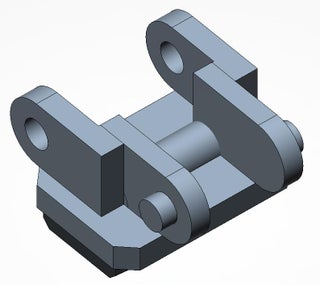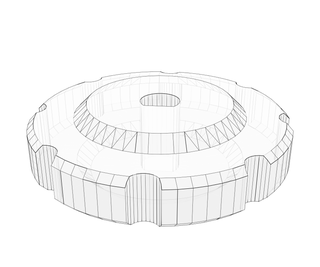Introduction: Robot Caterpillar Tank Treads, Johnny Five Style - 3D Print
 When I was but a wee little inventor, I saw a movie that forever imprinted itself into my soul. This picture told the gripping tale of mans' ever loosening control over its own technology; a film that dared ask the question "What makes us alive?" This masterpiece of the cinema was, of course, Short Circuit 2.
When I was but a wee little inventor, I saw a movie that forever imprinted itself into my soul. This picture told the gripping tale of mans' ever loosening control over its own technology; a film that dared ask the question "What makes us alive?" This masterpiece of the cinema was, of course, Short Circuit 2.During November of 2012 I was fortunate enough to play as an Artist in Residence at the Instructables HQ, and was given full access to a room full of Object Connex 500 multiple material 3D printers! I had always wanted a toy version of the robot from Short Circuit, Johnny Five, and I found myself with the means to print one at my fingertips.
Later on I will be adding components to this robot until I have a completed, functional model. I was more concerned about getting the base to actually function than with it being an exact replica of the Johnny 5 robot, so I did wing it a bit with the design (aka: artist license.)
Bonus Trivia: The original design for the J5 robot was created by a concept artist named Syd Mead. Mead is best known for his design work for the movies Blade Runner and Tron, and he is considered a god among the concept drawing community. I highly suggest taking a deeper look into his work.
To begin, I drew a handful of rough pencil sketches just to give myself a an idea of how the treads could work and eventually moved the idea over into 123D beta 9. A copy of the model was printed, and the pieces of track snapped together just as intended.
 The treads where printed using one of the Objets more interesting features, the ability to print combinations of separate types of materials at the same time. The light blue areas of track are mostly a rigid white material with a pinch of rubbery black. This gives the print a solid structure with just enough flex to be snapped together. The rubber treads are more rubber than rigid, making an outer surface that gets much better traction than its light blue counterpart. Since the two materials are printed together they are permanently bonded.
The treads where printed using one of the Objets more interesting features, the ability to print combinations of separate types of materials at the same time. The light blue areas of track are mostly a rigid white material with a pinch of rubbery black. This gives the print a solid structure with just enough flex to be snapped together. The rubber treads are more rubber than rigid, making an outer surface that gets much better traction than its light blue counterpart. Since the two materials are printed together they are permanently bonded.When it came time to make this hub for the track I tried to build around my initial tread design, but the geometry just wouldn't work out. I ended up starting from scratch by drawing a hub first and a track made to fit around it. The new parts were printed out, assembled and tested. Happily, the mechanics flowed like they were made for each other! I tweaked the tolerances by .05 mm or so and printed a few dozen links.
The base is held together with short 0-80 thread machine screws that go through one side of the enclosure and attach to holes on the opposing side. Although these holes are included in the model, and the printer did render them, I still found it necessary to use small drill bits to adjust tolerances and remove support material.
Motors are secured in place with mounts built into the two halves of the base. To get the motors to fit perfectly I ended up making a model of the gear motors from dimensions taken with a digital caliper. The motor mounts were then designed around that virtual motor.
Thanks for checking my project. Keep an eye out for more Johnny Instructables as I make progress on the build. Feel free to ask me questions, give suggestions and leave feedback.


 Attached files:
Attached files:I started this model in 123D beta 9 but have moved it to Inventor Fusion. Both sets include DWG and STL format files.
Tread Set includes files for a single segment of tread, a drive single hub, and a free spinning hub. Since each piece of track is the same, more copies of the track segment are printed to make the entire length. The drive hub is designed to fit on a the end of a small gear head motor, but could certainly be modified to fit other types. The free spin hub is made to fitted with an axle and simply roll along with the track.
Johnny9 Base Set holds the files for the the complete drive base as seen in the pictures.
Small Brass Gear Motor files are for the motor only and are intended to be used as reference
















